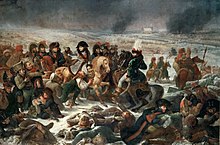 |
 |
• • • Aryzad/sandbox/Portal:Wars • • •
The Roman–Persian Wars were a series of conflicts between states of the Greco-Roman world and two successive Iranian empires: the Parthian and the Sasanian. Battles between the Parthian Empire and the Roman Republic began in 66 BC; wars began under the late Republic, and continued through the Roman (later Byzantine) and Sasanian empires. Various vassal kingdoms and allied nomadic nations in the form of buffer states and proxies also played a role. The wars were ended by the Arab Muslim Conquests, which led to the fall of the Sasanian Empire and huge territorial losses for the Byzantine Empire, shortly after the end of the last war between them.
• • • Selected picture • • •
Portal:Napoleonic Wars/Pictures/3
• • • Selected battle • • •
 Napoleon's armies previously smashed the army of the Austrian Empire in the Ulm Campaign and the combined Austrian and Russian armies at the Battle of Austerlitz on 2 December 1805. Austerlitz forced the Austrians to sue for peace and their Russian allies to withdraw from the conflict. On 14 October 1806, Napoleon crushed the armies of the Kingdom of Prussia at the Battle of Jena–Auerstedt. After a rapid pursuit, the broken pieces of the Prussian army were destroyed at the Battles of Prenzlau and Lübeck and in a series of capitulations at Erfurt, Pasewalk, Stettin, Magdeburg, and Hamelin. Eylau was the first serious check to the Grande Armée and the myth of Napoleon's invincibility was badly shaken. In late January, Bennigsen's Russian army went on the offensive in East Prussia, pushing far to the west. Napoleon reacted by mounting a counter-offensive to the north, hoping to prevent their retreat to the east. After his cossacks captured a copy of Napoleon's orders, Bennigsen rapidly withdrew to the north-east to avoid being cut off. The French pursued for several days and found the Russians drawn up for battle at Eylau. In a vicious evening clash, the French captured the village with heavy losses on both sides. The following day brought even more serious fighting. Early in the battle, a frontal attack by Napoleon failed with catastrophic losses. To retrieve the situation, the emperor launched a massed cavalry charge against the Russians. This bought enough time for the French right wing to throw its weight into the contest. Soon, the Russian left wing was bent back at an acute angle and Bennigsen's army was in danger of collapse. A Prussian corps belatedly arrived and saved the day by pushing back the French right wing. As darkness fell, a French corps tardily appeared on the French left flank. That night Bennigsen decided to retreat, leaving Napoleon in possession of a snowy battlefield covered with thousands of corpses and many more wounded. |
• • • Selected biography • • •
• • • Selected good articles • • •
• • • Did you know? • • •
• • • Categories • • •
• • • WikiProjects • • •
• • • Related portals • • •
• • • Reading material • • •
• • • Featured articles • • •
• • • Related topics • • •
• • • Wikimedia • • •
| Parthian-Roman warson Commons | Persian-Roman warson Commons |
{{featured portal}}

